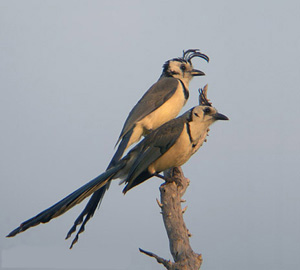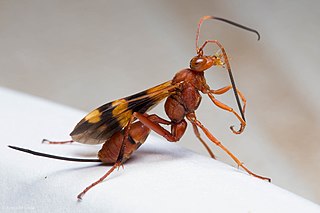Genus is a taxonomic rank used in the biological classification of living and fossil organisms as well as viruses, in biology. In the hierarchy of biological classification, genus comes above species and below family. In binomial nomenclature, the genus name forms the first part of the binomial species name for each species within the genus.

The lagomorphs are the members of the taxonomic order Lagomorpha, of which there are two living families: the Leporidae and the Ochotonidae (pikas). The name of the order is derived from the Ancient Greek lagos + morphē. There are 102 extant species of lagomorph, including 37 species of pika, 33 species of rabbit and cottontail, and 32 species of hare.

The nutcrackers (Nucifraga) are a genus of three species of passerine bird, in the family Corvidae, related to the jays and crows.

Salamandridae is a family of salamanders consisting of true salamanders and newts. Salamandrids are distinguished from other salamanders by the lack of rib or costal grooves along the sides of their bodies and by their rough skin. Their skin is very granular because of the number of poison glands. They also lack nasolabial grooves. Most species of Salamandridae have moveable eyelids but lack lacrimal glands.

The Chironomidae comprise a family of nematoceran flies with a global distribution. They are closely related to the Ceratopogonidae, Simuliidae, and Thaumaleidae. Many species superficially resemble mosquitoes, but they lack the wing scales and elongated mouthparts of the Culicidae. An example of mosquito-resembling species is Tokunagayusurika akamusi.

The genus Eligmodontia consists of five or six species of South American sigmodontine mice restricted to Bolivia, Chile, and Argentina. Species of Eligmodontia occur along the eastern side of the Andes Mountains, in Patagonia, and in the Chaco thorn forest of South America. They can be found in arid and semiarid habitats and in both high and low elevation areas. These rodents are commonly known as gerbil mice or by their local name lauchas. Sometimes they are also called silky desert mice, highland desert mice or silky-footed mice. The closest living relatives are probably the chaco mice (Andalgalomys), the leaf-eared mice, and Salinomys.

Spirorbis is a genus of very small polychaete worms, usually with a white coiled shell. Members of the genus live in the lower littoral and sublittoral zones of rocky shores. Spirorbis worms usually live attached to seaweeds, but some species live directly on rocks, shells or other hard substrates. Spirorbis was once thought to have a fossil record extending back into the Early Paleozoic, but now all pre-Cretaceous spirorbins are known to be microconchids. The earliest members of genus appeared in the Miocene, but Oligocene finds may also be possible. The genus contains the following species:

The Lonchaeidae are a family of acalyptrate flies commonly known as lance flies. About 500 described species are placed into 9 genera. These are generally small but robustly built flies with blue-black or metallic bodies. They are found, mainly in wooded areas, throughout the world with the exception of polar regions and New Zealand.

Fodies are small passerine birds belonging to the genus Foudia in the weaver family Ploceidae.
Oligoryzomys victus, also known as the St. Vincent colilargo or St. Vincent pygmy rice rat, is a species of rodent in the genus Oligoryzomys of the oryzomyine tribe. Only one specimen is known, which was collected on Saint Vincent in the Lesser Antilles in about 1892, and it is now presumed extinct.

Chrysoritis, commonly called opals or coppers, is a genus of butterflies in the family Lycaenidae found mainly in southern Africa and particularly South Africa.

The magpie-jays are a genus, Calocitta, of the family Corvidae native to the southern part of North America. Sometimes placed in the genus Cyanocorax. The two known species are known to form hybrids.
The Perissommatidae are a family of flies (Diptera) that was proposed in 1962 by Donald Colless based on the species Perissomma fusca from Australia. The family now includes five species, four from Australia and one from Chile. The Perissommatidae are unusual as they appear to have four compound eyes. They have a small slender body less than 2 mm in length. Their wings are large in comparison to their bodies and subsequently their flight is weak. Preferring high-altitude forest environments, adults only fly in the winter. The larvae live in decaying leaf litter in wet sclerophyll or cool rain forests. Some species are suspected to be associated with fungi. In the case of Perissomma macalpinei, numbers of adults have been observed congregating in clumps of foliage and rising in short, zigzag flights in the sunlight above the foliage for short periods before descending.

Genus plc is a British-based business selling elite genetics and other products manufactured using biotechnology to cattle and pig farmers. It is headquartered in Basingstoke and is a constituent of the FTSE 250 Index.
Orophosaurus is an dubious genus of elasmosaurid plesiosaur from the Late Cretaceous of New Mexico.

Chironomini is a tribe of midges in the non-biting midge family (Chironomidae).
Procyclotosaurus is an extinct genus of stenotosaurid capitosaurian temnospondyl. The type species is P. stantonensis. In 1904, English paleontologist Arthur Smith Woodward described it as a species of Capitosaurus, C. stantonensis, based on a partial skull known as R 3174. In 1958, the species was assigned to the new genus. It is known from the Lower Keuper, a European stratigraphic unit that was deposited during the late Middle Triassic. Fossils have been found from Staffordshire, England.

Meroktenos is a genus of basal sauropodomorph dinosaur that lived during the Late Triassic period of what is now Lesotho.

Compsocryptus is a genus of ichneumon wasps in the family Ichneumonidae. There are at least 18 described species in Compsocryptus.












